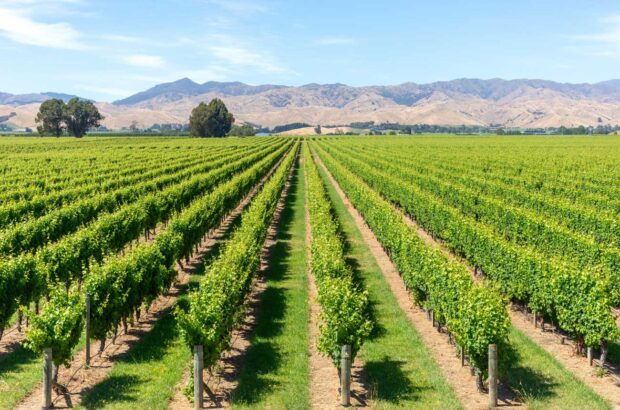‘When it comes to Vitis vinifera genetic diversity, the New World could save the Old World.’ This dramatic statement was made in 2023 by Dr Etienne Neethling, a South Africa-born viticulture researcher now working in France.
This view may be surprising, considering the country that’s home to the largest number of native vinifera grape varieties is Italy. But in general, there has been a dramatic reduction in genetic diversity within many of the ‘noble’ grape varieties over the last century.
Today it’s rare to find a commercial vineyard with more than three or four clones of a variety such as Cabernet Sauvignon.
The situation is different in the wine-growing nations generally still referred to as the New World. Argentina, in particular, has remained a sort of Galapagos Island for same-variety Vitis vinifera genetic diversity – for Malbec and a few other varieties.
This is partly due to its economic and political isolation throughout the second half of the 20th century. But it is also because Argentina has continued to plant vines ungrafted, by massal selection – propagating new vines by taking cuttings from the best-quality vine stock – while most of the world moved to grafted clones.
{"content":"PHA+QWNjb3JkaW5nIHRvIEFyZ2VudGluYeKAmXMgbmF0aW9uYWwgaW5zdGl0dXRlIGZvciB2aXRpY3VsdHVyZSBJTlYgKDxlbT5JbnN0aXR1dG8gTmFjaW9uYWwgZGUgVml0aXZpbmljdWx0dXJhPC9lbT4pLCBhYm91dCA4OSUgb2YgQXJnZW50aW5h4oCZcyB2aW5leWFyZHMgYXJlIHVuZ3JhZnRlZCBhbmQgbWFzc2FsLXNlbGVjdGVkOyBpbmRlZWQgdGhlcmUgY291bGQgYmUgbW9yZSB0aGFuIDE1MCwwMDAgaGVjdGFyZXMgb2YgdW5ncmFmdGVkLCBtYXNzYWwgcGxhbnRpbmdzIGluIEFyZ2VudGluYSwgYWNjb3JkaW5nIHRvIGFuZWNkb3RhbCBldmlkZW5jZSBmcm9tIHJlc2VhcmNoZXJzLjwvcD4KPHA+SWYgdHJ1ZSwgdGhpcyB3b3VsZCBtYWtlIEFyZ2VudGluYSB0aGUgY291bnRyeSB3aXRoIHRoZSBsYXJnZXN0IGFyZWEgb2YgdW5ncmFmdGVkLCBtYXNzYWwgdmluZXlhcmRzIGluIHRoZSB3b3JsZC48L3A+CjxwPldoaWxlIEZyYW5jZSBhbmQgSXRhbHkgaGF2ZSBiZWd1biBlZmZvcnRzIHRvIHByZXNlcnZlIG1hc3NhbCBzZWxlY3Rpb25zIOKAkyBpbiBzb21lIGNhc2VzIGV2ZW4gdW5ncmFmdGVkIG1hc3NhbHMg4oCTIGV2ZW4gY29tYmluZWQgdGhleSBoYXZlIGZld2VyIHBsYW50aW5ncyB0aGFuIEFyZ2VudGluYS4gVGhlcmUgYXJlIGFsc28gb2xkIHZpbmV5YXJkcyB3aXRoIHVuZ3JhZnRlZCBtYXNzYWxzIGluIDxzdHJvbmc+PGEgaHJlZj0iaHR0cHM6Ly93d3cuZGVjYW50ZXIuY29tL3RhZy9jaGlsZS8iIHRhcmdldD0iX2JsYW5rIiByZWw9Im5vb3BlbmVyIj5DaGlsZTwvYT48L3N0cm9uZz4sIDxzdHJvbmc+PGEgaHJlZj0iaHR0cHM6Ly93d3cuZGVjYW50ZXIuY29tL3dpbmUtdHJhdmVsL3NvdXRoLWFmcmljYS8iIHRhcmdldD0iX2JsYW5rIiByZWw9Im5vb3BlbmVyIj5Tb3V0aCBBZnJpY2E8L2E+PC9zdHJvbmc+LCBHcmVlY2UsIHRoZSA8c3Ryb25nPjxhIGhyZWY9Imh0dHBzOi8vd3d3LmRlY2FudGVyLmNvbS9wcmVtaXVtL3NwYWlucy1leGNpdGluZy1pc2xhbmQtd2luZXMtY2FuYXJpZXMtYW5kLWJhbGVhcmljcy00Mzg4NTEvIiB0YXJnZXQ9Il9ibGFuayIgcmVsPSJub29wZW5lciI+Q2FuYXJ5IElzbGFuZHM8L2E+PC9zdHJvbmc+LCBQb3J0dWdhbCwgQXVzdHJhbGlhLCB0aGUgVVMgYW5kIG1vcmUg4oCTIGJ1dCB0aGVyZSBpcyBubyBvZmZpY2lhbCByZWdpc3RyeSBvZiB0aGVpciBzdXJmYWNlIGFyZWEuPC9wPgo8ZGl2IGNsYXNzPSJhZC1jb250YWluZXIgYWQtY29udGFpbmVyLS1tb2JpbGUiPjxkaXYgaWQ9InBvc3QtaW5saW5lLTMiIGNsYXNzPSJpcGMtYWR2ZXJ0Ij48L2Rpdj48L2Rpdj4KPGhyPgo8ZGl2IGNsYXNzPSJicmVha291dCBwYWxldHRlLWEgcGFuZWwgcGFuZWwtZGVmYXVsdCI+PGRpdiBjbGFzcz0icGFuZWwtYm9keSI+PGRpdiBjbGFzcz0nYnJlYWtvdXQtY29udGVudCc+PC9wPgo8aDM+R3JhcGV2aW5lIHByb3BhZ2F0aW9uOiBrZXkgdGVybXM8L2gzPgo8cD48c3BhbiBzdHlsZT0iZm9udC13ZWlnaHQ6IDQwMCI+PHN0cm9uZz5WYXJpZXR5Ojwvc3Ryb25nPiBBIHZhcmlhdGlvbiB3aXRoaW4gYSBzcGVjaWVzLCBlaXRoZXIgbmF0dXJhbGx5ICh0aHJvdWdoIGdlbmV0aWMgbXV0YXRpb25zLCBuYXR1cmFsIHNlbGVjdGlvbiBvciBnZW9ncmFwaGljIGlzb2xhdGlvbiksIG9yIGJ5IGh1bWFuIGRlc2lnbiAodGhyb3VnaCBsb25nLXRlcm0gc2VsZWN0aW9uIGFuZCBwcm9wYWdhdGlvbikuIEZvciBleGFtcGxlLCBDYWJlcm5ldCBTYXV2aWdub24gaXMgYSB2YXJpZXR5IG9mIHRoZSBzcGVjaWVzIDxlbT5WaXRpcyB2aW5pZmVyYTwvZW0+Ljwvc3Bhbj48L3A+CjxkaXYgY2xhc3M9ImFkLWNvbnRhaW5lciBhZC1jb250YWluZXItLW1vYmlsZSI+CjxkaXYgaWQ9InBvc3QtaW5saW5lLTQiIGNsYXNzPSJpcGMtYWR2ZXJ0Ij48L2Rpdj4KPC9kaXY+CjxwPjxzcGFuIHN0eWxlPSJmb250LXdlaWdodDogNDAwIj48c3Ryb25nPkNsb25lOjwvc3Ryb25nPiBBIHNwZWNpZmljIGl0ZXJhdGlvbiBvZiBhIHZhcmlldHkgdGhhdCBpcyB2ZWdldGF0aXZlbHkgcHJvcGFnYXRlZCAodGhyb3VnaCBsYXllcmluZyBvciBncmFmdGluZykgYmVjYXVzZSBvZiBpdHMgZGVzaXJhYmxlIHRyYWl0cyAoYmV0dGVyIHRhc3RlLCBkaXNlYXNlLXJlc2lzdGFuY2UsIGV0YykgaW4gYSBnaXZlbiBlbnZpcm9ubWVudC4gR2VuZXRpY2FsbHksIGNsb25lcyBhcmUgaWRlbnRpY2FsIHRvIHRoZSBtb3RoZXIgdmluZS7CoDwvc3Bhbj48L3A+CjxwPjxzcGFuIHN0eWxlPSJmb250LXdlaWdodDogNDAwIj48c3Ryb25nPkNsb25hbCBzZWxlY3Rpb246PC9zdHJvbmc+IEEgbWV0aG9kIG9mIHZpbmUgcHJvcGFnYXRpb24gaW4gd2hpY2ggaW5kaXZpZHVhbCBncmFwZXZpbmVzIHdpdGggZGVzaXJhYmxlIHRyYWl0cyBhcmUgc2VsZWN0ZWQgYW5kIG11bHRpcGxpZWQgYnkgdmVnZXRhdGl2ZSBwcm9wYWdhdGlvbi4gQSBjbG9uYWxseSBzZWxlY3RlZCB2aW5leWFyZCB3aWxsIGNvbnRhaW4gZ2VuZXRpY2FsbHkgaWRlbnRpY2FsIHZpbmUgbWF0ZXJpYWwuwqA8L3NwYW4+PC9wPgo8ZGl2IGNsYXNzPSJhZC1jb250YWluZXIgYWQtY29udGFpbmVyLS1tb2JpbGUiPgo8ZGl2IGlkPSJwb3N0LWlubGluZS01IiBjbGFzcz0iaXBjLWFkdmVydCI+PC9kaXY+CjwvZGl2Pgo8cD48c3BhbiBzdHlsZT0iZm9udC13ZWlnaHQ6IDQwMCI+PHN0cm9uZz5NYXNzYWwgc2VsZWN0aW9uOjwvc3Ryb25nPiBBIG1ldGhvZCBvZiB2aW5lIHByb3BhZ2F0aW9uIGluIHdoaWNoIGN1dHRpbmdzIGFyZSB0YWtlbiBmcm9tIGEgc2VsZWN0aW9uIG9mIGJlc3QtcGVyZm9ybWluZyB2aW5lcyBhbmQgbXVsdGlwbGllZCB0aHJvdWdoIHZlZ2V0YXRpdmUgcHJvcGFnYXRpb24uIEEgbWFzc2FsLXNlbGVjdGVkIHZpbmV5YXJkIHdpbGwgY29udGFpbiBnZW5ldGljYWxseSBkaXZlcnNlIHZpbmUgbWF0ZXJpYWwuPC9zcGFuPjwvcD4KPHA+CjwvZGl2PjxkaXYgY2xhc3M9J2JyZWFrb3V0LWJ1dHRvbnMnPjxkaXYgY2xhc3M9J3Jvdyc+PC9kaXY+PC9kaXY+PC9kaXY+PC9kaXY+Cjxocj4KPGgyPkF0dGFjayBvZiB0aGUgY2xvbmVzPC9oMj4KPHA+SG93IGRpZCBBcmdlbnRpbmEgY29tZSB0byBob2xkIHNvIG1hbnkgdW5ncmFmdGVkLCBtYXNzYWwgdmluZXM\/IFVudGlsIHRoZSBlYXJseSAyMDAwcywgbGl0dGxlIGdlbmV0aWMgbWF0ZXJpYWwgZW50ZXJlZCB0aGUgY291bnRyeSBmcm9tIGFicm9hZC4gSW4gZmFjdCwgbWFueSBvZiB0aGUgdmluZXMgcGxhbnRlZCBpbiBBcmdlbnRpbmEgYXJlIHRoZSBkZXNjZW5kYW50cyBvZiB2aW5lcyBpbXBvcnRlZCBmcm9tIEZyYW5jZSAodmlhIENoaWxlKSBkdXJpbmcgdGhlIDE5dGggY2VudHVyeSwgYmVmb3JlIHRoZSA8c3Ryb25nPjxhIGhyZWY9Imh0dHBzOi8vd3d3LmRlY2FudGVyLmNvbS9sZWFybi9waHlsbG94ZXJhLTQ2MTI5LyIgdGFyZ2V0PSJfYmxhbmsiIHJlbD0ibm9vcGVuZXIiPnBoeWxsb3hlcmE8L2E+IDwvc3Ryb25nPmJ1ZyBwZXN0IHNwcmVhZCBvdXQgZnJvbSBub3J0aGVybiBBbWVyaWNhIHRvIGRldmFzdGF0ZSB2aW5leWFyZHMgYWNyb3NzIEV1cm9wZSBhbmQgZXZlbnR1YWxseSB0aGUgd29ybGQgb3Zlci48L3A+CjxwPkl0IHdhcyBvbmx5IEFyZ2VudGluYeKAmXMgZW1lcmdlbmNlIGFzIGEgbWFqb3Igd2luZSBleHBvcnRlciBkdXJpbmcgdGhlIDIxc3QgY2VudHVyeSDigJMgd2hpY2ggcHJvbXB0ZWQgdGhlIGFycml2YWwgb2YgZm9yZWlnbiBpbnZlc3RvcnMgYW5kIGZseWluZyB3aW5lbWFrZXJzLCBjb21pbmcgaW4gZnJvbSBvdGhlciBjb3VudHJpZXMgYXMgY29uc3VsdGFudHMg4oCTIHRoYXQgcmVzdWx0ZWQgaW4gdGhlIGltcG9ydGF0aW9uIG9mIG1vZGVybiBjbG9uZXMgKHNlZSBhYm92ZSkuPC9wPgo8cD5JIGJlY2FtZSBhd2FyZSBvZiB0aGUgZG9taW5hbmNlIG9mIGNsb25hbCBwbGFudGluZ3Mgb3V0c2lkZSBBcmdlbnRpbmEgaW4gdGhlIGVhcmx5IDIwMDBzLCBkdWUgdG8gYSBjaGFuY2UgZW5jb3VudGVyIHdpdGggPHN0cm9uZz48YSBocmVmPSJodHRwczovL3d3dy5kZWNhbnRlci5jb20vZmVhdHVyZXMvZGVjYW50ZXItbWFuLW9mLXRoZS15ZWFyLWF1YmVydC1kZS12aWxsYWluZS0yNDY0MjkvIiB0YXJnZXQ9Il9ibGFuayIgcmVsPSJub29wZW5lciI+QXViZXJ0IGRlIFZpbGxhaW5lPC9hPjwvc3Ryb25nPiBvZiBCdXJndW5keeKAmXMgPHN0cm9uZz48YSBocmVmPSJodHRwczovL3d3dy5kZWNhbnRlci5jb20vcHJlbWl1bS9kb21haW5lLWRlLWxhLXJvbWFuZWUtY29udGktcHJvZmlsZS13aW5lLXJhdGluZ3MtMzg0ODc2LyIgdGFyZ2V0PSJfYmxhbmsiIHJlbD0ibm9vcGVuZXIiPkRvbWFpbmUgZGUgbGEgUm9tYW7DqWUtQ29udGk8L2E+PC9zdHJvbmc+IGF0IHRoZSBOYXBsZXMgV2luZSBBdWN0aW9uIGluIEZsb3JpZGEuIEkgbWVudGlvbmVkIHRoYXQgSSBoYWQgYmVlbiBtYWtpbmcgTHVjYSBQaW5vdCBOb2lyIGluIE1lbmRvemEgc2luY2UgMTk5OS48L3A+CjxwPkhlIHBvbGl0ZWx5IGVucXVpcmVkOiDigJhIYXZlIHlvdSBwbGFudGVkIHRoZSBEaWpvbiBjbG9uZXM\/4oCZIEkgcHJvdWRseSByYXR0bGVkIG9mZjogMTE1LCA3NzcsIDY2NywgUG9tbWFyZCYjODIzMDsgSGUgcmVwbGllZCB0aGF0IGhpcyB2aW5leWFyZHMgd2VyZSBwbGFudGVkIHdpdGggbWFzc2FsIHNlbGVjdGlvbnMgb2YgPHN0cm9uZz48YSBocmVmPSJodHRwczovL3d3dy5kZWNhbnRlci5jb20vd2luZS9ncmFwZS12YXJpZXRpZXMvcGlub3Qtbm9pci8iIHRhcmdldD0iX2JsYW5rIiByZWw9Im5vb3BlbmVyIj5QaW5vdCBOb2lyPC9hPjwvc3Ryb25nPiBhbmQgbm90IHdpdGggRGlqb24gY2xvbmVzLjwvcD4KPHA+Tm93LCBtYXNzYWwgc2VsZWN0aW9uOiB0aGF0IHdhcyBzb21ldGhpbmcgSSBjb3VsZCByZWFsbHkgdGFsayBhYm91dCEgSXQgaGFkIGJlZW4gb3VyIGZhbWlseeKAmXMgbWV0aG9kIG9mIHBsYW50aW5nIHNpbmNlIG15IEl0YWxpYW4gZ3JlYXQtZ3JhbmRmYXRoZXIgZ3JldyBoaXMgZmlyc3QgdmluZXMgaW4gPHN0cm9uZz48YSBocmVmPSJodHRwczovL3d3dy5kZWNhbnRlci5jb20vbWFnYXppbmUvZml2ZS1zdHVubmluZy1kYXlzLWluLW1lbmRvemEtNTEwMTUwLyIgdGFyZ2V0PSJfYmxhbmsiIHJlbD0ibm9vcGVuZXIiPk1lbmRvemE8L2E+IDwvc3Ryb25nPmluIDE5MDIuIFdoYXQgZm9sbG93ZWQgd2FzIG9uZSBvZiB0aGUgbW9zdCBjcnVjaWFsIGNvbnZlcnNhdGlvbnMgb2YgbXkgbGlmZS48L3A+CjxwPldoZW4gaGUgaGVhcmQgdGhhdCB3ZSBoYWQgaHVuZHJlZHMgb2YgdGhvdXNhbmRzIG9mIGhlY3RhcmVzIG9mIG1hc3NhbCB2aW5leWFyZHMgaW4gQXJnZW50aW5hLCBkZSBWaWxsYWluZSBjb252aW5jZWQgbWUgdGhhdCB0aGlzIHdhcyBleHRyZW1lbHkgc3BlY2lhbC4gSGUgd2lzaGVkIHRoYXQgaGUgY291bGQgaGF2ZSBtYXNzYWwgUGlub3QgTm9pciB2aW5leWFyZHMgaW4gPHN0cm9uZz48YSBocmVmPSJodHRwczovL3d3dy5kZWNhbnRlci5jb20vd2luZS93aW5lLXJlZ2lvbnMvYnVyZ3VuZHktd2luZS8iIHRhcmdldD0iX2JsYW5rIiByZWw9Im5vb3BlbmVyIj5CdXJndW5keTwvYT48L3N0cm9uZz4sIGxpa2Ugd2UgaGF2ZSBmb3IgTWFsYmVjIGluIEFyZ2VudGluYS48L3A+CjxkaXYgaWQ9ImF0dGFjaG1lbnRfNTM3ODI3IiBzdHlsZT0id2lkdGg6IDYxMHB4IiBjbGFzcz0id3AtY2FwdGlvbiBhbGlnbm5vbmUiPjxpbWcgZmV0Y2hwcmlvcml0eT0iaGlnaCIgZGVjb2Rpbmc9ImFzeW5jIiBhcmlhLWRlc2NyaWJlZGJ5PSJjYXB0aW9uLWF0dGFjaG1lbnQtNTM3ODI3IiBjbGFzcz0ibGF6eWxvYWQgYmx1ci11cCBzaXplLWZ1bGwgd3AtaW1hZ2UtNTM3ODI3IiBkYXRhLXByb2Nlc3NlZCBzcmM9Imh0dHBzOi8vd3d3LmRlY2FudGVyLmNvbS93cC1jb250ZW50L3RoZW1lcy9zaW1iYS10aGVtZS9hc3NldHMvaW1hZ2VzL3BsYWNlaG9sZGVyLnBuZyIgZGF0YS1zcmM9Imh0dHBzOi8va2V5YXNzZXRzLnRpbWVpbmN1ay5uZXQvaW5zcGlyZXdwL2xpdmUvd3AtY29udGVudC91cGxvYWRzL3NpdGVzLzM0LzIwMjQvMDkvREVDMzAyLm1hc3NhbF9zZWxlY3Rpb24ubmljb2xhX3NfY2F0ZW5hX3Zpbl9lZG9fc3VwZXJzb19uaWNvLmpwZyIgYWx0PSIiIHdpZHRoPSI2MDAiIGhlaWdodD0iNDAwIiBkYXRhLXNpemVzPSJhdXRvIiBkYXRhLXNyY3NldD0iaHR0cHM6Ly9rZXlhc3NldHMudGltZWluY3VrLm5ldC9pbnNwaXJld3AvbGl2ZS93cC1jb250ZW50L3VwbG9hZHMvc2l0ZXMvMzQvMjAyNC8wOS9ERUMzMDIubWFzc2FsX3NlbGVjdGlvbi5uaWNvbGFfc19jYXRlbmFfdmluX2Vkb19zdXBlcnNvX25pY28uanBnIDYwMHcsIGh0dHBzOi8va2V5YXNzZXRzLnRpbWVpbmN1ay5uZXQvaW5zcGlyZXdwL2xpdmUvd3AtY29udGVudC91cGxvYWRzL3NpdGVzLzM0LzIwMjQvMDkvREVDMzAyLm1hc3NhbF9zZWxlY3Rpb24ubmljb2xhX3NfY2F0ZW5hX3Zpbl9lZG9fc3VwZXJzb19uaWNvLTMwMHgyMDAuanBnIDMwMHcsIGh0dHBzOi8va2V5YXNzZXRzLnRpbWVpbmN1ay5uZXQvaW5zcGlyZXdwL2xpdmUvd3AtY29udGVudC91cGxvYWRzL3NpdGVzLzM0LzIwMjQvMDkvREVDMzAyLm1hc3NhbF9zZWxlY3Rpb24ubmljb2xhX3NfY2F0ZW5hX3Zpbl9lZG9fc3VwZXJzb19uaWNvLTEzNXg5MC5qcGcgMTM1dywgaHR0cHM6Ly9rZXlhc3NldHMudGltZWluY3VrLm5ldC9pbnNwaXJld3AvbGl2ZS93cC1jb250ZW50L3VwbG9hZHMvc2l0ZXMvMzQvMjAyNC8wOS9ERUMzMDIubWFzc2FsX3NlbGVjdGlvbi5uaWNvbGFfc19jYXRlbmFfdmluX2Vkb19zdXBlcnNvX25pY28tMzIweDIxMy5qcGcgMzIwdyIgc2l6ZXM9IihtYXgtd2lkdGg6IDYwMHB4KSAxMDB2dywgNjAwcHgiIC8+PHAgaWQ9ImNhcHRpb24tYXR0YWNobWVudC01Mzc4MjciIGNsYXNzPSJ3cC1jYXB0aW9uLXRleHQiPkRyIExhdXJhIENhdGVuYSBhbmQgc3RhZmYgYXQgdGhlIE5pY29sw6FzIENhdGVuYSBWacOxZWRvIFN1cGVyc8OzbmljbyB2aW5lIG51cnNlcnkuIENyZWRpdDogTGF1cmEgQ2F0ZW5hLjwvcD48L2Rpdj4KPGgyPk5hdHVyYWwgc2VsZWN0aW9uPC9oMj4KPHA+U28gaG93IGRpZCB0aGlzIHNpdHVhdGlvbiBhcmlzZT8gSXQgc3RhcnRlZCBsaWtlIG1hbnkgb3RoZXIgaHVtYW4gZW5kZWF2b3Vycywgd2l0aCBwZW9wbGUgdHJ5aW5nIHRvIGltcHJvdmUgb24gbmF0dXJlLiBTZWxlY3Rpb24gb2YgdGhlIG1vc3QgcHJvZHVjdGl2ZSBjcm9wcyBmb3IgZmFybWluZyBkYXRlcyBiYWNrIHRvIE5lb2xpdGhpYyB0aW1lcyB3aGVuIGVhcmx5IGh1bWFucyB0cmFuc2l0aW9uZWQgZnJvbSBodW50aW5nIGFuZCBnYXRoZXJpbmcgdG8gZmFybWluZy48L3A+CjxwPlBsYW50cyBhbmQgc2VlZHMgd2VyZSBzZWxlY3RlZCB3aXRoIGRlc2lyYWJsZSB0cmFpdHMgc3VjaCBhcyBoaWdoZXIgeWllbGRzLCBiZXR0ZXIgdGFzdGUgb3IgZGlzZWFzZSByZXNpc3RhbmNlLjwvcD4KPHA+UG9zc2libHkgYXMgZmFyIGJhY2sgYXMgMTAsMDAwIHllYXJzIGFnbywgZ3JhcGUgY3VsdGl2YXRpb24gdXNlZCBtYXNzYWwgc2VsZWN0aW9ucy4gQnkgdGhlIGxhdGUgMTgwMHMsIGFmdGVyIHRoZSBpbml0aWFsIGRhbWFnZSBvZiB0aGUgcGh5bGxveGVyYSBjcmlzaXMsIEFtZXJpY2FuIGFuZCBFdXJvcGVhbiB2aXRpY3VsdHVyaXN0cyBzYXZlZCB0aGVpciB3aW5lbWFraW5nIHJlZ2lvbnMgYnkgZ3JhZnRpbmcgPGVtPlZpdGlzIHZpbmlmZXJhPC9lbT4gdmFyaWV0aWVzIG9udG8gdGhlIHBoeWxsb3hlcmEtcmVzaXN0YW50IHJvb3RzdG9ja3Mgb2YgQW1lcmljYW4gdmluZSBzcGVjaWVzLjwvcD4KPHA+R3JhZnRpbmcgcmVxdWlyZWQgc2lnbmlmaWNhbnQgdGVjaG5pY2FsIGV4cGVydGlzZS4gVGhlIGFydCBvZiBtYXNzYWwgcHJvcGFnYXRpb24g4oCTIHdoZXJlYnkgYSB5ZWFy4oCZcyBwcnVuaW5nIG1hdGVyaWFscyB3b3VsZCBiZSBwbGFudGVkIGluIHBvdHMgYW5kIHVzZWQgdG8gY3JlYXRlIGEgbmV3IHZpbmV5YXJkIOKAkyB3YXMgc3Vic3RpdHV0ZWQgYnkgdmluZSBudXJzZXJpZXMgYW5kIGEgbW9yZSBjb250cm9sbGVkIGZvcm0gb2YgcHJvcGFnYXRpb24uPC9wPgo8cD5JbiB0aGlzIHNldHRpbmcsIGl0IG1hZGUgc2Vuc2UgdG8gcmVwcm9kdWNlIGp1c3QgYSBmZXcgc2VsZWN0IGNsb25lcyDigJMgcXVhbGl0YXRpdmUgY2xvbmVzIHRoYXQgd291bGQgYWxsIHJpcGVuIGF0IGEgc2ltaWxhciB0aW1lIOKAkyBvZiBsZWFkaW5nIHZhcmlldGllcyBzdWNoIGFzIDxzdHJvbmc+PGEgaHJlZj0iaHR0cHM6Ly93d3cuZGVjYW50ZXIuY29tL3dpbmUvZ3JhcGUtdmFyaWV0aWVzL2NoYXJkb25uYXkvIiB0YXJnZXQ9Il9ibGFuayIgcmVsPSJub29wZW5lciI+Q2hhcmRvbm5heTwvYT48L3N0cm9uZz4sIENhYmVybmV0IFNhdXZpZ25vbiBhbmQgUGlub3QgTm9pci48L3A+CjxwPkZyb20gdGhlIG1pZC0yMHRoIGNlbnR1cnksIHBsYW50aW5nIGJ5IG1hc3NhbCBzZWxlY3Rpb24gd2FzIG1vc3RseSBhYmFuZG9uZWQgYW5kIHRoZSBwb3B1bGFyIEVOVEFWIGNsb25lcyAoc3RhbmRpbmcgZm9yIDxlbT5FdGFibGlzc2VtZW50IE5hdGlvbmFsIFRlY2huaXF1ZSBwb3VyIGzigJlBbWVsaW9yYXRpb24gZGUgbGEgVml0aWN1bHR1cmU8L2VtPiwgRU5UQVYgaXMgdGhlIGdsb2JhbGx5IHVzZWQgRnJlbmNoIGFnZW5jeSBzZXQgdXAgdG8gaWRlbnRpZnkgYW5kIGFkbWluaXN0ZXIgYXBwcm92ZWQgdmluZSBjbG9uZXMpLCBpbmNsdWRpbmcgdGhlIFBpbm90IE5vaXIgRGlqb24gY2xvbmVzLCBiZWNhbWUgdGhlIHN5bWJvbCBvZiB0aGUgaGlnaGVzdC1xdWFsaXR5IHZpbmV5YXJkcyBpbiB0aGUgd29ybGQuPC9wPgo8ZGl2IGlkPSJhdHRhY2htZW50XzUzNzgyOCIgc3R5bGU9IndpZHRoOiA2MTBweCIgY2xhc3M9IndwLWNhcHRpb24gYWxpZ25ub25lIj48aW1nIGRlY29kaW5nPSJhc3luYyIgYXJpYS1kZXNjcmliZWRieT0iY2FwdGlvbi1hdHRhY2htZW50LTUzNzgyOCIgY2xhc3M9Imxhenlsb2FkIGJsdXItdXAgc2l6ZS1mdWxsIHdwLWltYWdlLTUzNzgyOCIgZGF0YS1wcm9jZXNzZWQgc3JjPSJodHRwczovL3d3dy5kZWNhbnRlci5jb20vd3AtY29udGVudC90aGVtZXMvc2ltYmEtdGhlbWUvYXNzZXRzL2ltYWdlcy9wbGFjZWhvbGRlci5wbmciIGRhdGEtc3JjPSJodHRwczovL2tleWFzc2V0cy50aW1laW5jdWsubmV0L2luc3BpcmV3cC9saXZlL3dwLWNvbnRlbnQvdXBsb2Fkcy9zaXRlcy8zNC8yMDI0LzA5L0RFQzMwMi5tYXNzYWxfc2VsZWN0aW9uLmNhdGVuYV9jdXR0aW5nc19wcmVfcGh5bGxveGVyYV9tYWxiZWMwMS5qcGciIGFsdD0iIiB3aWR0aD0iNjAwIiBoZWlnaHQ9IjQwMCIgZGF0YS1zaXplcz0iYXV0byIgZGF0YS1zcmNzZXQ9Imh0dHBzOi8va2V5YXNzZXRzLnRpbWVpbmN1ay5uZXQvaW5zcGlyZXdwL2xpdmUvd3AtY29udGVudC91cGxvYWRzL3NpdGVzLzM0LzIwMjQvMDkvREVDMzAyLm1hc3NhbF9zZWxlY3Rpb24uY2F0ZW5hX2N1dHRpbmdzX3ByZV9waHlsbG94ZXJhX21hbGJlYzAxLmpwZyA2MDB3LCBodHRwczovL2tleWFzc2V0cy50aW1laW5jdWsubmV0L2luc3BpcmV3cC9saXZlL3dwLWNvbnRlbnQvdXBsb2Fkcy9zaXRlcy8zNC8yMDI0LzA5L0RFQzMwMi5tYXNzYWxfc2VsZWN0aW9uLmNhdGVuYV9jdXR0aW5nc19wcmVfcGh5bGxveGVyYV9tYWxiZWMwMS0zMDB4MjAwLmpwZyAzMDB3LCBodHRwczovL2tleWFzc2V0cy50aW1laW5jdWsubmV0L2luc3BpcmV3cC9saXZlL3dwLWNvbnRlbnQvdXBsb2Fkcy9zaXRlcy8zNC8yMDI0LzA5L0RFQzMwMi5tYXNzYWxfc2VsZWN0aW9uLmNhdGVuYV9jdXR0aW5nc19wcmVfcGh5bGxveGVyYV9tYWxiZWMwMS0xMzV4OTAuanBnIDEzNXcsIGh0dHBzOi8va2V5YXNzZXRzLnRpbWVpbmN1ay5uZXQvaW5zcGlyZXdwL2xpdmUvd3AtY29udGVudC91cGxvYWRzL3NpdGVzLzM0LzIwMjQvMDkvREVDMzAyLm1hc3NhbF9zZWxlY3Rpb24uY2F0ZW5hX2N1dHRpbmdzX3ByZV9waHlsbG94ZXJhX21hbGJlYzAxLTMyMHgyMTMuanBnIDMyMHciIHNpemVzPSIobWF4LXdpZHRoOiA2MDBweCkgMTAwdncsIDYwMHB4IiAvPjxwIGlkPSJjYXB0aW9uLWF0dGFjaG1lbnQtNTM3ODI4IiBjbGFzcz0id3AtY2FwdGlvbi10ZXh0Ij5BIE1hbGJlYyB2aW5lIHByb3BhZ2F0ZWQgZnJvbSBhIHByZS1waHlsbG94ZXJhIGN1dHRpbmcgYXQgdGhlIENhdGVuYSBJbnN0aXR1dGUgb2YgV2luZS4gQ3JlZGl0OiBMYXVyYSBDYXRlbmEuPC9wPjwvZGl2Pgo8aDI+TGFjayBvZiBkaXZlcnNpdHk8L2gyPgo8cD5BZnRlciB0aGUgaWRlbnRpZmljYXRpb24gb2YgdmluZXlhcmQgdmlydXNlcyBhcm91bmQgdGhpcyB0aW1lLCBpbnN0aXR1dGlvbnMgc3VjaCBhcyBGUFMgKEZvdW5kYXRpb24gUGxhbnQgU2VydmljZXMpIGluIHRoZSBVUyBhbmQgSU5SQSAobmFtZWQgSU5SQUUgc2luY2UgYSAyMDIwIG1lcmdlcikgaW4gRnJhbmNlIGRldmVsb3BlZCBjZXJ0aWZpY2F0aW9uIHByb2dyYW1zIGZvciBzaW5nbGUtdmFyaWV0eSBjbG9uZXMuPC9wPgo8cD5WaXJ1cyB0ZXN0aW5nIGFuZCB2aXJ1cy1jbGVhbmluZyBvZiBwbGFudCBtYXRlcmlhbCBpcyBhIGNvbXBsZXggYW5kIGV4cGVuc2l2ZSBlbmRlYXZvdXIsIGFuZCBpdCBtYWRlIGVjb25vbWljIHNlbnNlIHRvIHVuZGVydGFrZSB0aGVzZSBwcm9jZWR1cmVzIG9ubHkgZm9yIHRoZSBiZXN0IGNsb25lcyBvZiBlYWNoIHZhcmlldHkuIFNhZGx5LCB2aXJ1cy1pbmZlY3RlZCBwbGFudCBtYXRlcmlhbCB3YXMgb2Z0ZW4gZGlzY2FyZGVkLCB3aGljaCBtZWFucyB0aGF0IHdlIGhhdmUgYWxyZWFkeSBsb3N0IG11Y2ggb2YgdGhlIGRpdmVyc2l0eSBmb3Igbm9ibGUgdmFyaWV0aWVzIHN1Y2ggYXMgQ2FiZXJuZXQgU2F1dmlnbm9uIGFuZCBDaGFyZG9ubmF5LjwvcD4KPHA+QXQgdGhlIHNhbWUgdGltZSwgZ292ZXJubWVudCByZXNlYXJjaCBpbnN0aXR1dGlvbnMgYXJvdW5kIHRoZSB3b3JsZCBiZWdhbiB0byBjb2xsZWN0IGFuZCBpZGVudGlmeSBpbmRpdmlkdWFsIGN1dHRpbmdzIG9mIDxlbT5WaXRpcyB2aW5pZmVyYTwvZW0+IHZhcmlldGllcyB0byBwcmVzZXJ2ZSBpbiByZWdpb25hbCB2aW5lIG51cnNlcmllcywgdGFraW5nIHByZWNhdXRpb25zIHRvIGtlZXAgdGhlbSBmcmVlIG9mIHZpcnVzZXMuPC9wPgo8cD5JIG9mdGVuIHJlZmVyIHRvIHRoZXNlIGdvdmVybm1lbnQgbnVyc2VyaWVzIGFzIOKAmHBsYW50IHpvb3PigJkgYmVjYXVzZSB0aGUgZGl2ZXJzZSBnZW5ldGljIG1hdGVyaWFsIGlzIHByZXNlcnZlZCBpbiBzbWFsbCBxdWFudGl0aWVzIOKAkyBtYXliZSBzaXggcGxhbnRzIHBlciBnZW5vdHlwZSAodGhhdCBpcywgYSBwYXJ0aWN1bGFyIGdlbmV0aWMgaXRlcmF0aW9uIG9mIGEgZ3JhcGUgdmFyaWV0eSkuPC9wPgo8cD5JbiBzdW1tYXJ5LCB0aGUg4oCYY2xvbmFsIGVyYeKAmSBvZiB0aGlzIGxhc3QgY2VudHVyeSBoYXMgcmVzdWx0ZWQgaW4gdGhlIHdvcmxk4oCZcyBjb21tZXJjaWFsIHZpbmV5YXJkcyBiZWluZyBwbGFudGVkIHdpdGggYSByZWR1Y2VkIHBvcHVsYXRpb24gb2YgaW5kaXZpZHVhbCBjbG9uZXMsIGFzIG9wcG9zZWQgdG8gd2hhdCB3ZSBoYXZlIGluIEFyZ2VudGluYSDigJMgbmFtZWx5IHRob3VzYW5kcyBvZiBoZWN0YXJlcyBvZiBnZW5ldGljYWxseSBkaXZlcnNlLCB1bmdyYWZ0ZWQgbWFzc2FsIHZpbmV5YXJkcy48L3A+CjxwPlN1Y2ggYSB2aXRpY3VsdHVyYWwgZW52aXJvbm1lbnQgaXMgbm90IHdpdGhvdXQgaXRzIGNoYWxsZW5nZXMuIEluIEFyZ2VudGluYSwgdGhyZWF0cyB0byBwcm9kdWN0aW9uIGZyb20gbmVtYXRvZGVzIGFuZCB3YXRlciBzY2FyY2l0eSBtYXkgY29tcGVsIHByb2R1Y2VycyB0byByZXBsYW50IHdpdGggdmlydXMtZnJlZSBjbG9uZXMgYW5kIHJvb3RzdG9ja3MuIFNvIGhvdyBjYW4gdGhlc2UgcHJlY2lvdXMsIGdlbmV0aWNhbGx5IGRpdmVyc2UgdmluZXlhcmRzIGFuZCB0aGUgdHJhZGl0aW9uYWwgbWV0aG9kIG9mIHBsYW50aW5nIGJ5IG1hc3NhbCBzZWxlY3Rpb24gYmUgcHJlc2VydmVkPzwvcD4KPGgyPkEgc3BlY2lhbCBjYXNlPC9oMj4KPHA+U3R1ZGllcyBieSB0aGUgQ2F0ZW5hIEluc3RpdHV0ZSBvZiBXaW5lIGhhdmUgc2hvd24gdGhhdCBBcmdlbnRpbmHigJlzIHVuZ3JhZnRlZCwgbWFzc2FsIE1hbGJlYyB2aW5leWFyZHMgYXJlIHNwZWNpYWwuIFRoZWlyIHlpZWxkcyBhcmUgb24gYXZlcmFnZSA3NSUgbG93ZXIgdGhhbiB0aG9zZSBwcm9kdWNlZCBieSB0aGUgdWJpcXVpdG91cyBDw7R0IGNsb25lcyBjb21tZXJjaWFsbHkgYXZhaWxhYmxlIG91dHNpZGUgQXJnZW50aW5hLjwvcD4KPHA+R3Jvd24gaW4gc3BlY2lhbCBwbGFjZXMgbGlrZSBvdXIgQWRyaWFubmEgVmluZXlhcmQgYXQgMSw0NTBtIGVsZXZhdGlvbiBpbiBHdWFsdGFsbGFyeSBNb25hc3RlcmlvLCBtYXNzYWwgTWFsYmVjIHByb2R1Y2VzIGFuIGFnZXdvcnRoeSwgZmxvcmFsLCBkYXJrIHdpbmUsIHdpdGggbWluZXJhbCBub3RlcyBhbmQgYSB1bmlxdWUgY29tYmluYXRpb24gb2YgYm90aCByb3VnaCBhbmQgc2lsa3kgdGFubmlucy48L3A+CjxwPkluIDE5OTUsIHRoZSBDYXRlbmEgSW5zdGl0dXRlIG9mIFdpbmUgdW5kZXJ0b29rIGEgc2VsZWN0aW9uIG9mIDEzMyBNYWxiZWMgY3V0dGluZ3Mg4oCTIDEyMCBmcm9tIG91ciBvd24gQW5nw6lsaWNhIFZpbmV5YXJkIChwbGFudGVkIGluIDE5MjQpIGFuZCAxMyBmcm9tIHB1YmxpYyBjb2xsZWN0aW9ucyBhdCBJTlRBIChBcmdlbnRpbmHigJlzIG5hdGlvbmFsIGluc3RpdHV0ZSBvZiBhZ3JpY3VsdHVyYWwgdGVjaG5vbG9neSkgYW5kIHRoZSBGYWN1bHR5IGZvciBBZ3JhcmlhbiBTY2llbmNlcyDigJMgd2hpY2ggd2UgaGF2ZSBzdHVkaWVkIGFuZCByZXByb2R1Y2VkLiBXZSBoYXZlIGZvdW5kIHRoYXQgeWllbGRzIGNhbiB2YXJ5IGJ5IGFzIG11Y2ggYXMgMTAgdGltZXMgYmV0d2VlbiB0aGUgbW9zdCBhbmQgbGVhc3QgcHJvZHVjdGl2ZSBNYWxiZWMgY3V0dGluZ3MuPC9wPgo8cD5TdWdhciByaXBlbmVzcyBpbiBncmFwZXMgYXQgaGFydmVzdCB0aW1lIGNhbiB2YXJ5IGJ5IDTCsCBCcml4LCB3aGljaCBjb3VsZCBtZWFuIGEgbW9udW1lbnRhbCB0d28tcG9pbnQgZGlmZmVyZW5jZSBpbiB0aGUgZmluYWwgYWxjb2hvbCBsZXZlbCBvZiB0aGUgd2luZSBtYWRlLiA8c3Ryb25nPjxhIGhyZWY9Imh0dHBzOi8vd3d3LmRlY2FudGVyLmNvbS9sZWFybi93aGF0LWhhcHBlbnMtZHVyaW5nLXZlcmFpc29uLTM3Mzc1Mi8iIHRhcmdldD0iX2JsYW5rIiByZWw9Im5vb3BlbmVyIj5WZXJhaXNvbjwvYT4gPC9zdHJvbmc+dGltZSAodGhlIG9uc2V0IG9mIHJpcGVuaW5nLCB3aGVuIGNvbG91ciBiZWdpbnMgdG8gY2hhbmdlIGluIGJsYWNrIGdyYXBlcykgY2FuIGRpZmZlciBieSB1cCB0byBlaWdodCBkYXlzIGZvciB0d28gZGlmZmVyZW50IGN1dHRpbmdzIGluIHRoZSBzYW1lIHRlcnJvaXIuPC9wPgo8cD5JbiBkaWZmaWN1bHQgdmludGFnZXMsIG91ciBnZW5ldGljYWxseSBkaXZlcnNlIG1hc3NhbCBwbGFudGluZ3MgYXJlIHRoZSBtb3N0IHJlc2lsaWVudCwgYmVjYXVzZSBhIHNwcmluZyBmcm9zdCB3aWxsIHJlc3VsdCBpbiBsZXNzIGRhbWFnZSB0byB2aW5lcyBpZiB0aGV5IGFyZSBhdCBkaWZmZXJlbnQgc3RhZ2VzIG9mIHJpcGVuaW5nLiBTbyBpdCBpcyBubyBzdXJwcmlzZSB0aGF0IG91ciBiZXN0IE1hbGJlYywgQ2FiZXJuZXQgU2F1dmlnbm9uIGFuZCA8c3Ryb25nPjxhIGhyZWY9Imh0dHBzOi8vd3d3LmRlY2FudGVyLmNvbS9hcmdlbnRpbmEtMjAxNC1jb3ZlcmFnZS9ib25hcmRhLWEtdW5pcXVlLXZhcmlldGFsLW9mLWFyZ2VudGluYS13aXRoLWdyZWF0LXBvdGVudGlhbC0zMDU2MS8iIHRhcmdldD0iX2JsYW5rIiByZWw9Im5vb3BlbmVyIj5Cb25hcmRhPC9hPiA8L3N0cm9uZz53aW5lcyBjb21lIGZyb20gdW5ncmFmdGVkLCBtYXNzYWwgdmluZXlhcmRzLjwvcD4KPGRpdiBpZD0iYXR0YWNobWVudF81Mzc4MzUiIHN0eWxlPSJ3aWR0aDogNjEwcHgiIGNsYXNzPSJ3cC1jYXB0aW9uIGFsaWdubm9uZSI+PGltZyBkZWNvZGluZz0iYXN5bmMiIGFyaWEtZGVzY3JpYmVkYnk9ImNhcHRpb24tYXR0YWNobWVudC01Mzc4MzUiIGNsYXNzPSJsYXp5bG9hZCBibHVyLXVwIHNpemUtZnVsbCB3cC1pbWFnZS01Mzc4MzUiIGRhdGEtcHJvY2Vzc2VkIHNyYz0iaHR0cHM6Ly93d3cuZGVjYW50ZXIuY29tL3dwLWNvbnRlbnQvdGhlbWVzL3NpbWJhLXRoZW1lL2Fzc2V0cy9pbWFnZXMvcGxhY2Vob2xkZXIucG5nIiBkYXRhLXNyYz0iaHR0cHM6Ly9rZXlhc3NldHMudGltZWluY3VrLm5ldC9pbnNwaXJld3AvbGl2ZS93cC1jb250ZW50L3VwbG9hZHMvc2l0ZXMvMzQvMjAyNC8wOS9Eci1MYXVyYS1DYXRlbmEtd2l0aC1FeGVjdXRpdmUtRGlyZWN0b3Itb2YtdGhlLUNhdGVuYS1JbnN0aXR1dGUtb2YtV2luZS1GZXJuYW5kby1CdXNjZW1hLi1DcmVzaXQtQ2F0ZW5hLUluc3RpdHV0ZS1vZi1XaW5lLmpwZyIgYWx0PSIiIHdpZHRoPSI2MDAiIGhlaWdodD0iNDAwIiBkYXRhLXNpemVzPSJhdXRvIiBkYXRhLXNyY3NldD0iaHR0cHM6Ly9rZXlhc3NldHMudGltZWluY3VrLm5ldC9pbnNwaXJld3AvbGl2ZS93cC1jb250ZW50L3VwbG9hZHMvc2l0ZXMvMzQvMjAyNC8wOS9Eci1MYXVyYS1DYXRlbmEtd2l0aC1FeGVjdXRpdmUtRGlyZWN0b3Itb2YtdGhlLUNhdGVuYS1JbnN0aXR1dGUtb2YtV2luZS1GZXJuYW5kby1CdXNjZW1hLi1DcmVzaXQtQ2F0ZW5hLUluc3RpdHV0ZS1vZi1XaW5lLmpwZyA2MDB3LCBodHRwczovL2tleWFzc2V0cy50aW1laW5jdWsubmV0L2luc3BpcmV3cC9saXZlL3dwLWNvbnRlbnQvdXBsb2Fkcy9zaXRlcy8zNC8yMDI0LzA5L0RyLUxhdXJhLUNhdGVuYS13aXRoLUV4ZWN1dGl2ZS1EaXJlY3Rvci1vZi10aGUtQ2F0ZW5hLUluc3RpdHV0ZS1vZi1XaW5lLUZlcm5hbmRvLUJ1c2NlbWEuLUNyZXNpdC1DYXRlbmEtSW5zdGl0dXRlLW9mLVdpbmUtMzAweDIwMC5qcGcgMzAwdywgaHR0cHM6Ly9rZXlhc3NldHMudGltZWluY3VrLm5ldC9pbnNwaXJld3AvbGl2ZS93cC1jb250ZW50L3VwbG9hZHMvc2l0ZXMvMzQvMjAyNC8wOS9Eci1MYXVyYS1DYXRlbmEtd2l0aC1FeGVjdXRpdmUtRGlyZWN0b3Itb2YtdGhlLUNhdGVuYS1JbnN0aXR1dGUtb2YtV2luZS1GZXJuYW5kby1CdXNjZW1hLi1DcmVzaXQtQ2F0ZW5hLUluc3RpdHV0ZS1vZi1XaW5lLTEzNXg5MC5qcGcgMTM1dywgaHR0cHM6Ly9rZXlhc3NldHMudGltZWluY3VrLm5ldC9pbnNwaXJld3AvbGl2ZS93cC1jb250ZW50L3VwbG9hZHMvc2l0ZXMvMzQvMjAyNC8wOS9Eci1MYXVyYS1DYXRlbmEtd2l0aC1FeGVjdXRpdmUtRGlyZWN0b3Itb2YtdGhlLUNhdGVuYS1JbnN0aXR1dGUtb2YtV2luZS1GZXJuYW5kby1CdXNjZW1hLi1DcmVzaXQtQ2F0ZW5hLUluc3RpdHV0ZS1vZi1XaW5lLTMyMHgyMTMuanBnIDMyMHciIHNpemVzPSIobWF4LXdpZHRoOiA2MDBweCkgMTAwdncsIDYwMHB4IiAvPjxwIGlkPSJjYXB0aW9uLWF0dGFjaG1lbnQtNTM3ODM1IiBjbGFzcz0id3AtY2FwdGlvbi10ZXh0Ij5EciBMYXVyYSBDYXRlbmEgd2l0aCBFeGVjdXRpdmUgRGlyZWN0b3Igb2YgdGhlIENhdGVuYSBJbnN0aXR1dGUgb2YgV2luZSwgRmVybmFuZG8gQnVzY2VtYS4gQ3JlZGl0OiBDYXRlbmEgSW5zdGl0dXRlIG9mIFdpbmUuPC9wPjwvZGl2Pgo8aDI+UmVzZWFyY2gsIGN1cnJlbnQgYW5kIGZlYXR1cmU8L2gyPgo8cD5PdGhlciBhcmVhcyBvZiBzdHVkeSBpbmNsdWRlIHRoZSBpbXBhY3Qgb2YgdmlydXNlcyBvbiBncmFmdGVkIHZlcnN1cyB1bmdyYWZ0ZWQgdmluZXlhcmRzLiBXZeKAmXJlIGFsc28gY29uc2lkZXJpbmcgZmxhdm91ciBwcm9maWxlLCBxdWFsaXR5IGFuZCBhZ2VhYmlsaXR5IG9mIHdpbmVzIGZyb20gbWFzc2FsIGFuZCBjbG9uYWwgdmluZXlhcmRzIGluIGRpZmZlcmVudCA8c3Ryb25nPjxhIGhyZWY9Imh0dHBzOi8vd3d3LmRlY2FudGVyLmNvbS93aW5lLW5ld3Mvb3Bpbmlvbi9hbmRyZXctamVmZm9yZC10ZWxsaW5nLXN0b3JpZXMtYWJvdXQtdGVycm9pci13aWxsLWxlYWQtdXMtYXN0cmF5LTQ4Mjk5MC8iIHRhcmdldD0iX2JsYW5rIiByZWw9Im5vb3BlbmVyIj50ZXJyb2lyczwvYT48L3N0cm9uZz4sIGFuZCByZXNlYXJjaGluZyB0aGUgZXBpZ2VuZXRpYyByZXNwb25zZSAoaG93IGludGVybmFsIG9yIGV4dGVybmFsIHN0aW11bGkgYWZmZWN0IGdlbmV0aWMgcmVzcG9uc2UpIG9mIHZpbmUgY3V0dGluZ3MgdG8gaGlnaC1hbHRpdHVkZSB0ZXJyb2lyLjwvcD4KPHA+T3VyIG1hc3NhbCB2aW5leWFyZCBjdXR0aW5ncyBhcmUgdW5pcXVlIGluIGJvdGggdGhlaXIgcHJlLXBoeWxsb3hlcmEgc3RhdHVzIGFuZCBpbiB0aGVpciBlcGlnZW5ldGljIGFkYXB0YXRpb25zIHRvIG91ciBoaWdoLWFsdGl0dWRlIGNsaW1hdGUuIEl04oCZcyBhbHNvIGltcG9ydGFudCB0byBjb25zaWRlciB0aGUgd2lkZXIgaW1wbGljYXRpb25zIG9mIHByZXNlcnZpbmcgaW50cmEtdmFyaWV0YWwgZ2VuZXRpYyBkaXZlcnNpdHkgaW4gdGhlIGZhY2Ugb2YgPHN0cm9uZz48YSBocmVmPSJodHRwczovL3d3dy5kZWNhbnRlci5jb20vd2luZS1uZXdzL3Rhc3RpbmctY2xpbWF0ZS1jaGFuZ2UtY29uZmVyZW5jZS0yMDI0LWtleS10YWtlYXdheXMtNTIyNDQyLyIgdGFyZ2V0PSJfYmxhbmsiIHJlbD0ibm9vcGVuZXIiPmNsaW1hdGUgY2hhbmdlPC9hPjwvc3Ryb25nPiDigJMgdGhpcyBpbmNsdWRlcyB0aGUgZmVhc2liaWxpdHkgb2YgdW5ncmFmdGVkIHZpbmV5YXJkcyB0byBjb3BlIHdpdGggd2F0ZXIgc2NhcmNpdHkuPC9wPgo8cD5PdXIgcGxhbnMgZm9yIHRoZSBmdXR1cmUgaW5jbHVkZSB0aGUgTmljb2zDoXMgQ2F0ZW5hIFZpw7FlZG8gU3VwZXJzw7NuaWNvLiBJbiB0aGlzIGlzb2xhdGVkLCB2aXJ1cy1mcmVlIHZpbmUgbnVyc2VyeSB3ZSBhcmUgcHJlc2VydmluZyBnZW5ldGljYWxseSBkaXZlcnNlIHNlbGVjdGlvbnMgb2YgTWFsYmVjLCBCb25hcmRhLCBDYWJlcm5ldCBTYXV2aWdub24sIDxzdHJvbmc+PGEgaHJlZj0iaHR0cHM6Ly93d3cuZGVjYW50ZXIuY29tL3dpbmUvZ3JhcGUtdmFyaWV0aWVzL3BldGl0LXZlcmRvdC8iIHRhcmdldD0iX2JsYW5rIiByZWw9Im5vb3BlbmVyIj5QZXRpdCBWZXJkb3Q8L2E+PC9zdHJvbmc+IGFuZCBDcmlvbGxhcywgYXMgd2VsbCBhcyBzb21lIHNwZWNpZmljIGNsb25lcyBvZiB0aGVzZSBhbmQgb3RoZXIgdmFyaWV0aWVzLjwvcD4KPHA+Vmllaml0byBkZSBSaXZhZGF2aWEgVmluZXlhcmQgaXMgYW5vdGhlciBpc29sYXRlZCBzaXRlIHdoZXJlIHdlIHByZXNlcnZlIG1hc3NhbCBzZWxlY3Rpb25zIGZyb20gb2xkIHZpbmVzIHJlc2N1ZWQgZnJvbSB2aW5leWFyZHMgdGhhdCBhcmUgYmVpbmcgcmVwbGFudGVkIG9yIHB1bGxlZCBvdXQgYmVjYXVzZSB0aGUgbGFuZCBpcyBiZWluZyBzb2xkIGZvciBob3VzaW5nIChzYWRseSwgdGhpcyBpcyBhbiBpbmNyZWFzaW5nbHkgZnJlcXVlbnQgc2l0dWF0aW9uKS48L3A+CjxwPlRoaXMgdmluZXlhcmQgaXMgcHVycG9zZWx5IG5vdCB2aXJ1cy1mcmVlLiBBcyBhIHNjaWVudGlzdCBJIGFtIGNvbnZpbmNlZCB0aGF0IHdpdGhpbiB0aGUgbmV4dCBkZWNhZGUsIHZpcnVzIHRlc3RpbmcgYW5kIGNsZWFuaW5nIHdpbGwgYmVjb21lIG11Y2ggbGVzcyBleHBlbnNpdmU7IHRoZXJlZm9yZSBvdXIgY3VycmVudCBwcmlvcml0eSBpcyB0byBwcmVzZXJ2ZSB0aGUgbGFyZ2VzdCBhbW91bnQgb2YgZ2VuZXRpY2FsbHkgZGl2ZXJzZSB2aW5lcyByYXRoZXIgdGhhbiBjbGVhbiBtYXRlcmlhbC48L3A+CjxwPkZpbmFsbHksIHdlIGFyZSBjb2xsYWJvcmF0aW5nIHdpdGggdGhlIGRpc3RyaWN0IG9mIDxzdHJvbmc+PGEgaHJlZj0iaHR0cHM6Ly93d3cuZGVjYW50ZXIuY29tL3ByZW1pdW0vcmVnaW9uYWwtcHJvZmlsZS1sdWphbi1kZS1jdXlvLXdpbmUtNDM2ODc2LyIgdGFyZ2V0PSJfYmxhbmsiIHJlbD0ibm9vcGVuZXIiPkx1asOhbiBkZSBDdXlvPC9hPjwvc3Ryb25nPiwgTWVuZG96YSwgb24gdGhlIDEwMC15ZWFyLW9sZCB2aW5leWFyZHMgcHJvamVjdC4gTHVqw6FuIGRlIEN1eW8gYm9hc3RzIHRoZSBsYXJnZXN0IGNvbmNlbnRyYXRpb24gb2YgY2VudGVuYXJpYW4gdmluZXMgaW4gQXJnZW50aW5hLCB3aXRoIDE1MCB2aW5leWFyZHMgY292ZXJpbmcgYXBwcm94aW1hdGVseSAxLDAwMGhhLCBhY2NvcmRpbmcgdG8gdGhlIElOViBpbnN0aXR1dGUgZm9yIHZpdGljdWx0dXJlLjwvcD4KPHA+VG9nZXRoZXIgd2l0aCBsb2NhbCByZXNlYXJjaGVycywgd2UgYXJlIHdvcmtpbmcgdG8gcHJlc2VydmUgbWFzc2FsIHNlbGVjdGlvbnMgb2YgTWFsYmVjIGZyb20gdGhlc2Ugb2xkIHZpbmV5YXJkcyB0aGF0IGFyZSBhdCBzaWduaWZpY2FudCByaXNrIG9mIGRpc2FwcGVhcmluZy4gV2Ugc2lnbiBhbiBhZmZpZGF2aXQgd2l0aCBhbGwgdmluZXlhcmQgb3duZXJzIHdobyBhcmUgcHJvdmlkaW5nIHVzIHdpdGggdmluZSBtYXRlcmlhbCwgc3RhdGluZyB0aGF0IGlmIGEgZnV0dXJlIGdlbmVyYXRpb24gb2YgdGhlaXIgZmFtaWx5IHdhbnRzIHRvIHBsYW50IGEgdmluZXlhcmQsIHdlIHdpbGwgcHJvdmlkZSB0aGUgY3V0dGluZ3MgZm9yIHRoZW0uPC9wPgo8ZGl2IGlkPSJhdHRhY2htZW50XzUzNzgzMCIgc3R5bGU9IndpZHRoOiA2MTBweCIgY2xhc3M9IndwLWNhcHRpb24gYWxpZ25ub25lIj48aW1nIGxvYWRpbmc9ImxhenkiIGRlY29kaW5nPSJhc3luYyIgYXJpYS1kZXNjcmliZWRieT0iY2FwdGlvbi1hdHRhY2htZW50LTUzNzgzMCIgY2xhc3M9Imxhenlsb2FkIGJsdXItdXAgc2l6ZS1mdWxsIHdwLWltYWdlLTUzNzgzMCIgZGF0YS1wcm9jZXNzZWQgc3JjPSJodHRwczovL3d3dy5kZWNhbnRlci5jb20vd3AtY29udGVudC90aGVtZXMvc2ltYmEtdGhlbWUvYXNzZXRzL2ltYWdlcy9wbGFjZWhvbGRlci5wbmciIGRhdGEtc3JjPSJodHRwczovL2tleWFzc2V0cy50aW1laW5jdWsubmV0L2luc3BpcmV3cC9saXZlL3dwLWNvbnRlbnQvdXBsb2Fkcy9zaXRlcy8zNC8yMDI0LzA5L0RFQzMwMi5tYXNzYWxfc2VsZWN0aW9uLmxhdXJhX2Zyb250LmpwZyIgYWx0PSIiIHdpZHRoPSI2MDAiIGhlaWdodD0iNDAwIiBkYXRhLXNpemVzPSJhdXRvIiBkYXRhLXNyY3NldD0iaHR0cHM6Ly9rZXlhc3NldHMudGltZWluY3VrLm5ldC9pbnNwaXJld3AvbGl2ZS93cC1jb250ZW50L3VwbG9hZHMvc2l0ZXMvMzQvMjAyNC8wOS9ERUMzMDIubWFzc2FsX3NlbGVjdGlvbi5sYXVyYV9mcm9udC5qcGcgNjAwdywgaHR0cHM6Ly9rZXlhc3NldHMudGltZWluY3VrLm5ldC9pbnNwaXJld3AvbGl2ZS93cC1jb250ZW50L3VwbG9hZHMvc2l0ZXMvMzQvMjAyNC8wOS9ERUMzMDIubWFzc2FsX3NlbGVjdGlvbi5sYXVyYV9mcm9udC0zMDB4MjAwLmpwZyAzMDB3LCBodHRwczovL2tleWFzc2V0cy50aW1laW5jdWsubmV0L2luc3BpcmV3cC9saXZlL3dwLWNvbnRlbnQvdXBsb2Fkcy9zaXRlcy8zNC8yMDI0LzA5L0RFQzMwMi5tYXNzYWxfc2VsZWN0aW9uLmxhdXJhX2Zyb250LTEzNXg5MC5qcGcgMTM1dywgaHR0cHM6Ly9rZXlhc3NldHMudGltZWluY3VrLm5ldC9pbnNwaXJld3AvbGl2ZS93cC1jb250ZW50L3VwbG9hZHMvc2l0ZXMvMzQvMjAyNC8wOS9ERUMzMDIubWFzc2FsX3NlbGVjdGlvbi5sYXVyYV9mcm9udC0zMjB4MjEzLmpwZyAzMjB3IiBzaXplcz0iKG1heC13aWR0aDogNjAwcHgpIDEwMHZ3LCA2MDBweCIgLz48cCBpZD0iY2FwdGlvbi1hdHRhY2htZW50LTUzNzgzMCIgY2xhc3M9IndwLWNhcHRpb24tdGV4dCI+RHIgTGF1cmEgQ2F0ZW5hIGlzIHdvcmtpbmcgdG8gcHJlc2VydmUgQXJnZW50aW5h4oCZcyB3ZWFsdGggb2YgZ2VuZXRpY2FsbHkgZGl2ZXJzZSBtYXNzYWwgdmluZXlhcmRzLjwvcD48L2Rpdj4KPGhyPgo8ZGl2IGNsYXNzPSJicmVha291dCBwYWxldHRlLWEgcGFuZWwgcGFuZWwtZGVmYXVsdCI+PGRpdiBjbGFzcz0icGFuZWwtYm9keSI+PGRpdiBjbGFzcz0nYnJlYWtvdXQtY29udGVudCc+PC9wPgo8aDI+T24gYmVjb21pbmcgYSB2aW5lIGRvY3RvcjwvaDI+CjxwPkFzIGEgeW91bmcgd29tYW4gc3R1ZHlpbmcgc2NpZW5jZSwgSSBmZWx0IHRoYXQgdGhlIGJlc3Qgd2F5IHRvIGhlbHAgdGhlIHdvcmxkIHVzaW5nIHNjaWVuY2Ugd291bGQgYmUgYnkgYmVjb21pbmcgYSBtZWRpY2FsIGRvY3RvciDigJMgd2hpY2ggSSBkaWQsIHNwZWNpZmljYWxseSBhbiBBY2NpZGVudCAmYW1wOyBFbWVyZ2VuY3kgZG9jdG9yLCBhIHByb2Zlc3Npb24gd2hpY2ggSSBwcmFjdGlzZWQgZm9yIDI3IHllYXJzIGluIHRoZSBVUyB3aGlsZSBhdCB0aGUgc2FtZSB0aW1lIHdvcmtpbmcgYXQgdGhlIENhdGVuYSBmYW1pbHkgd2luZXJ5IGluIEFyZ2VudGluYS48L3A+CjxkaXYgY2xhc3M9ImluamVjdGlvbiI+PC9kaXY+CjxwPlRvZGF5LCBJIGFtIGNvbW1pdHRlZCB0byBoZWxwaW5nIHRvIHByZXNlcnZlIHRoZSBuYXR1cmUgdGhhdCBzdXJyb3VuZHMgdXMsIHdoaWNoIGluY2x1ZGVzIGdlbmV0aWNhbGx5IGRpdmVyc2UgdmluZXlhcmRzIHRoYXQgYXJlIG1vcmUgcmVzaWxpZW50IHRvIGNsaW1hdGUgY2hhbmdlLiBJbiB0aGlzIHdheSwgSSBhbSBjb252aW5jZWQgdGhhdCBJIGNhbiBjb250aW51ZSB0byBoZWxwIHBlb3BsZSwgYXMgYSB2aW50bmVyLjwvcD4KPHA+SXTigJlzIG15IGJlbGllZiB0aGF0IHdpbmUgaW4gbW9kZXJhdGlvbiBjYW4gbWFrZSBvdXIgbGl2ZXMgbW9yZSBqb3lmdWwgYW5kIGludGVyZXN0aW5nLCBhbmQgcGVyaGFwcyBoZWxwIGFsbGV2aWF0ZSB0aGUgY3VycmVudCBsb25lbGluZXNzIGVwaWRlbWljLCBieSBlbmNvdXJhZ2luZyBqb3lmdWwgY29tcGFuaW9uc2hpcCBhdCB0aGUgdGFibGUuPC9wPgo8L2Rpdj48ZGl2IGNsYXNzPSdicmVha291dC1idXR0b25zJz48ZGl2IGNsYXNzPSdyb3cnPjwvZGl2PjwvZGl2PjwvZGl2PjwvZGl2Pgo8aHI+CjxwPgo="}
Related articles












